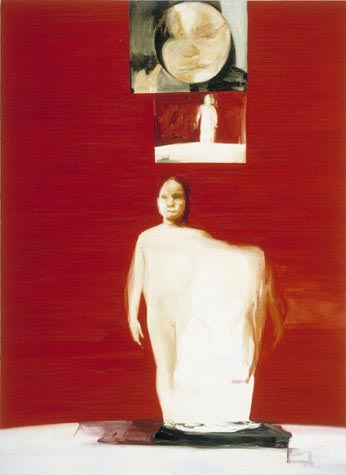Through the Looking-Glass, 2005 oil on panel, 54 1/2 x 41 1/3 inches, 138.7 x 105 cm Susanne Simonson Susanne Simonson, catalogue essay by Eva Runefelt, 2006 The first thought that springs to my mind when I see Susanne Simonson's work is a playful one. I recall a visit to the Skansen outdoor museum as a child - and the bright, shiny plastic pinwheels on sale outside the gates that rattled wildly when you ran or the wind got hold of them. It was a giddying discovery that movement could cause this transformation - the colours merged and could speak. The phenomenon appeared to erase boundaries. Colours could unexpectedly do as they liked, escape their outlines as if they had their own will and autonomy. This is related to what music can accomplish; the unparalleled ability of notes to make the world and even the listener levitate and weigh anchor. Both children and music are elements in Simonson's art. The child as a literal and figurative centre point, and the music this generates. It is not primarily the physical child that is concerned, but shifting atmospheres, primordial moods. The child is the hub of the picture, upright as if deep in thought, in half-profile or gracefully doing the splits. Like a bow, the young person spans the curve of the visible earth. This entire embracing gesture encompasses both that which rises upwards and that which bores itself downwards. The almost transparent figure is like the bubble in a water-level; balancing the lines and colour-play of the image. Out of the stillness and silence of this human centrepiece come Simonson's veritably musical compositions. Although they contain a romping, childish playfulness, there is an equal measure of sometimes frightening dance in between avertedness and presence, waking and dreaming, sociability and solitariness. There is a recurring gaze, a theme that runs through the paintings - here I am, but also somewhere else, for I am longing. The child permeates the world as the world permeates the child. Exposure is one side of the coin, and sensitivity the other. A weary little face is transformed into a grotesque clown's mask - or was it always there, merely hidden in the human expression? A fleeting face or body easily slips into non-figurativeness, as though it were only another side of the same being. Like a dervish Simonson's figures oscillate between corporeality and states of mind. The titles Susanne Simonson chooses are clues to her imagery - they hover on the boundary between intimacy and detachment, ecstasy and serenity. "Give Me Your Thoughts" (1999), "The Listener" (2001), "Far Away and Close" (2001), "The Light Darkness" (2003), "Flakes of Time" (2005). "The Scrutiniser" from 1999 shows a wildly staring, skull-like doll in front of a little girl whose face is dissolving in a reddish shimmer, as if blushing. In "Mirror World" (I and II, from 2003) the question is whether the human is being reflected by the image in the water, or if the water shadow is really the original face. This is a serious play with identity, and it is up to the onlooker to decide what the truth is. The artist snatches sections of the passing world and immerses herself deeply into these scattered moments. Thus, they can be painted into stability and memories. In Simonson's art colours play a crucial role, they can even determine which figures she creates. The colours are not illustrative or enhancing but controlling. Simonson's palette speaks of temperament and tempi, as it relates the body's density and dissolution. What happens is that Simonson allows nuances to entwine into shapes, in the same way that she also allows the opposite to happen: a reddish pink or iconic golden hue can forcefully rip asunder the human features in the painting and let colour be colour. Sheets, veils, wind. In the midst of these choreographic movements and this painterly dance, meditative concentration and whirling expressiveness meet and connect. Hapseis, from the Greek hapto, bind to, touch, is a word that Simonson uses again and again in the titles of her works. Simonson captures the transient, the fleeting excerpt in time that is merely the tips of icebergs that she then pulls through the eye of her needle, up into the daylight. Over the years, Susanne Simonson has processed her theme, refining it and letting it branch out. In her most recent works a new colour spectrum has emerged, and with it more sharply defined and clear figures. The child grows in the earthy brown and murky forest green. A viewer who is thrown into Simonson's reverberating, dancing world may be seized by severe vertigo, and yet, everything is perpetually the same: the constant onward urge, the volcanic force of change. The pinwheel with elusive colours drawing us into human being. Exhibition: May 11 - July 1, 2006 Gallery hours: Tues-Sat 11 am - 6 pm Feigen Contemporary Main Gallery 535 West 20th Street USA-New York, NY 10011 Telephone +1 212 929.0500 Fax +1 212 929.0065 Email Gallery@FeigenContemporary.com www.feigencontemporary.com |
|
